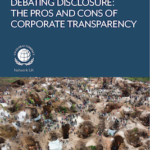The majority of Fortune 50 corporations use the Internet to disclose some information on their environmental performance but most are missing opportunities to involve stakeholders, tap the interactive potential of the web, and provide transparency in their reporting, new research suggests.
Researchers at Brigham Young University and KDPaine and Partners set out to test a new model for transparency, a hot topic in the field of corporate communications. After studying environmental information reported in the websites of F50 copanies, researchers found that a minority allow for any two-way interaction with stakeholders, which could inform and enhance the type of information they report.
"Make it more interactive," said Bradley Rawlins, the report’s co-author and chair of Brigham Young’s department of communications. "Open it up and let people comment because you might think you’re doing a good job but until your stakeholders say this is what they need, you don’t know."
The transparency standard researchers used to measure corporate environmental reporting includes four tenets: stakeholder participation in defining the type of information being reported; usefulness of information; balanced reporting that holds the company accountable for their performance; and a sense of openness in providing information that is easily available, easy to understand and timely.
"Measuring the Transparency of Environmental Sustainability Reporting Through Websites of Fortune 50 Corporations" found that few companies take advantage of the Interactive tools afforded by the Internet, such as blogs or discussion forums. Most reporting is static and one-way. For instance, the web allows for real-time reporting but all companies instead only report progress once a year.
Only 38 percent offered evidence of stakeholder involvement in the development of the reports. Most environmentally reporting was two to three mouse clicks away from the home page.
Many companies didn’t score well in providing balanced information or accountability. For example, only 36 percent reporting some sort of unfavorable result but only 6 percent included an explanation. Most lacked context to help readers understand the results. The results of only 13 percent of companies included third party verification.
Rawlins plans to expand the research in the coming months to include the Fortune 500.



